前面我们介绍了Kafka 生产者客户端的相关原理和网络模型,对于客户端消费者的网络模型,其实现要比生产者的设计还要复杂一些。今天我们主要讲述一下KafkaConsumer 网络模型的主要设计。
消息消费 Demo
对于消费者而言,在初始化 KafkaConsumer 实例时,通常会为其设置一系列的参数。这其中通常会为消费者指定 groupId,也就是消费者组的ID。通常情况下,多个消费者实例可以设置为同一个groupId。这样同一个 topic 不同分区上面的消息可以分流到不同的消费者实例上面去,从而实现消费的高吞吐。
核心组件
Kafka 消费者端的设计相对生产者要复杂一些,其中一个主要的原因就是,消费者组等相关概念的引入。其中包含了:ConsumerCoordinator、Fetcher、ConsumerNetworkClient 组件,其组合层级示意图如下所示:
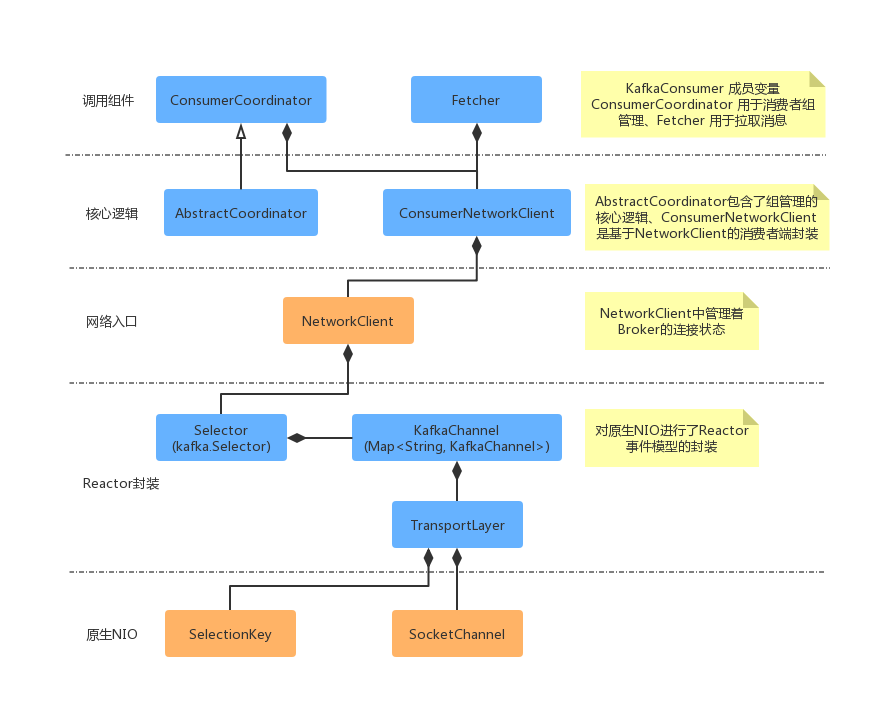
从上面主要组件关系可以看出,KafkaConsumer 有 2 个成员变量 ConsumerCoordinator 和 Fetcher。其中 ConsumerCoordinator 用来和服务端 Coordinator 交互通讯,提供消费者加入group 或者 reblance 的能力,也就是说在 Consumer 获取消息之前,一定是需要在一个 group 当中的。加入 group 完成之后,就是要获取数据了,Fetcher 组件提供了获取消息的能力,在其中做了一些增大吞吐量的优化,将在本篇后面介绍。ConsumerNetworkClient 是 ConsumerCoordinator 和 Fetcher 共同依赖的组件,它是基于 NetworkClient 的进一步封装。实现了Future 模式的结果获取,和线程安全相关的实现。
消费者调用整体流程
下面我们从 KafkaConsumer.poll() 为入口,看一下核心组件之间的调用关系。
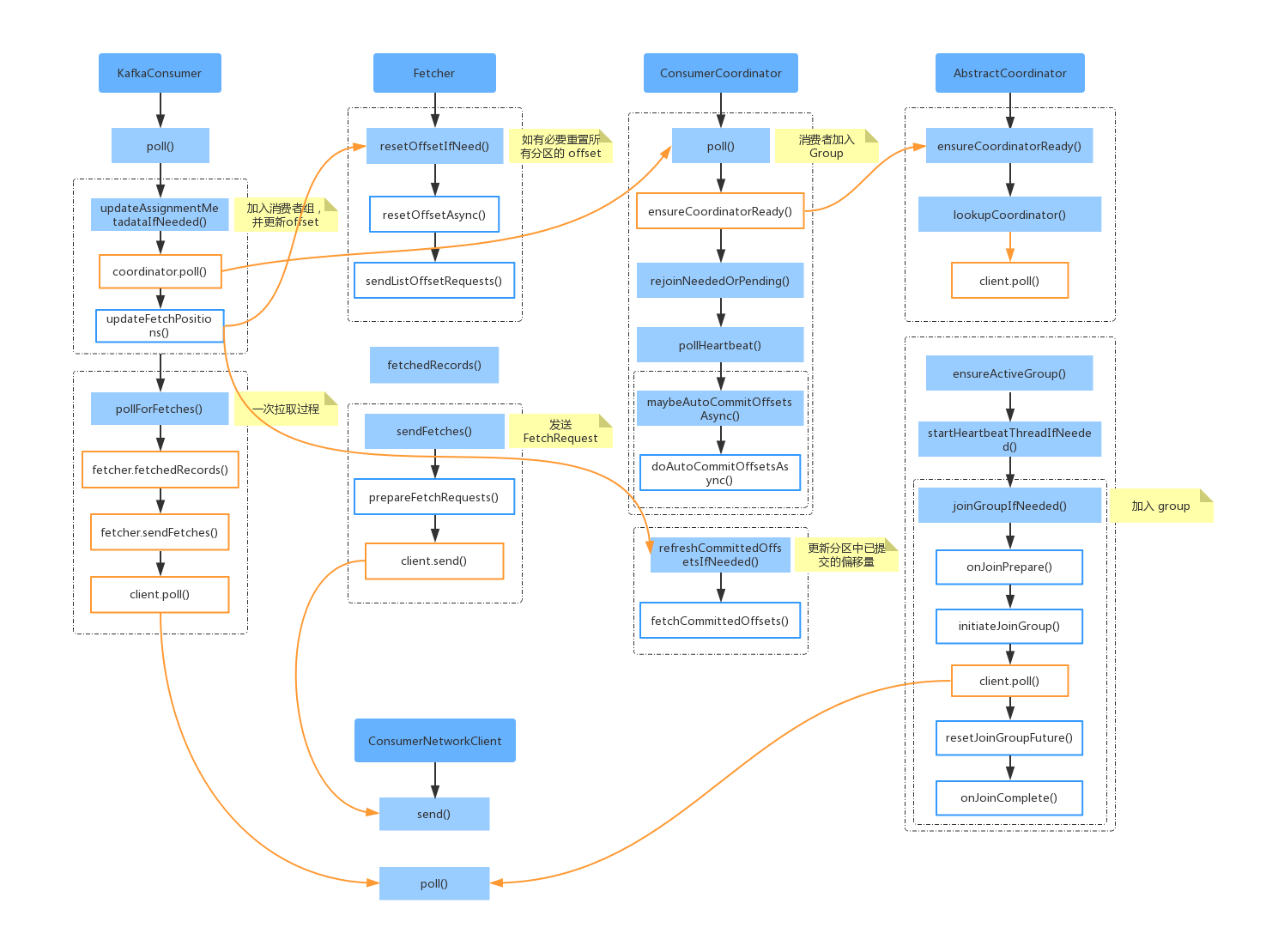 首先当我们调用 KafkaConsumer.poll() 时,首先会调用 updateAssignmentMetadataIfNeeded(),去确认当前消费者是否已经加入group。其中消费者组的协调工作是由 ConsumerCoordinator 组件提供能力的。之后会调用 pollForFetches() 执行消息拉取,拉取的工作是委派给 Fetcher 组件实现的。下面我们详细分析一下整体流程图中的实现。
首先当我们调用 KafkaConsumer.poll() 时,首先会调用 updateAssignmentMetadataIfNeeded(),去确认当前消费者是否已经加入group。其中消费者组的协调工作是由 ConsumerCoordinator 组件提供能力的。之后会调用 pollForFetches() 执行消息拉取,拉取的工作是委派给 Fetcher 组件实现的。下面我们详细分析一下整体流程图中的实现。
KafkaConsumer.poll()
我们首先看一下消息发送入口的方法实现:
KafkaConsumer.poll() 方法中首先会调用 updateAssignmentMetadataIfNeeded() 更新metadata元数据信息,保证消费者正确的加入group。然后就是发送拉取的请求 pollForFetches(),下面我们详细的看一下 pollForFetches() 的实现。
pollForFetches()
对于消息拉取的详细流程,上面代码中已经有注释描述。下面我们总结一下消息拉取时,上面代码做的一些优化操作。首先对于消息的拉取和处理主要流程如下所示:

对于KafkaConsumer.poll() 不断的去拉取消息的场景,此时如果两次拉取是串行的,这个时候可能就没有充分的利用KafkaConsumer 客户端的能力。因此我们从上面的代码中可以看出,在调用完 fetcher.fetchedRecords() 获取到结果之后,会异步的再去发起请求(fetcher.sendFetches())和轮询(client.poll()),以供下次拉取立即返回结果。
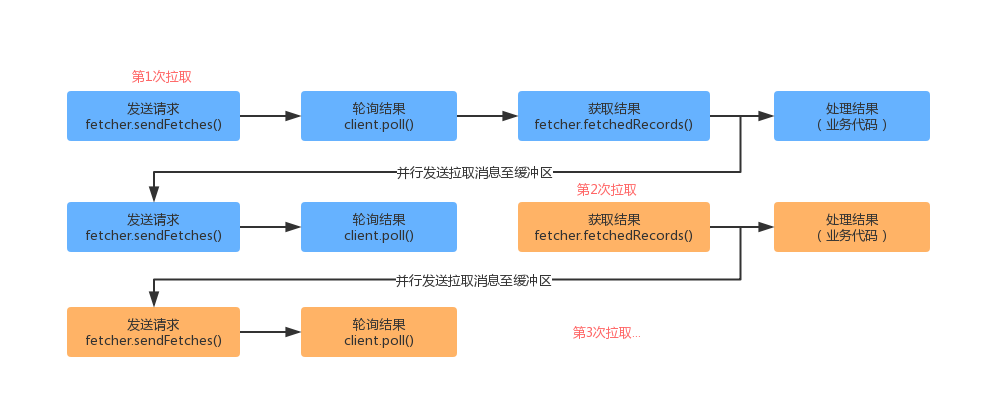
下面我们详细对发送请求(fetcher.sendFetches())、获取结果(fetcher.fetchedRecords())做详细介绍。
发送请求 Fetcher.sendFetches()
消费者 Fetcher 组件发送拉取请求的时候,也是和生产这类似,按照 Broker 的维度去发送请求。对于订阅的分区所属的节点信息,是存储在metadata 元数据信息里面的;对于消费者分区的消费位移 offset 是存储在订阅状态(SubscriptionState)中的。具体可用下面的流程图展示:
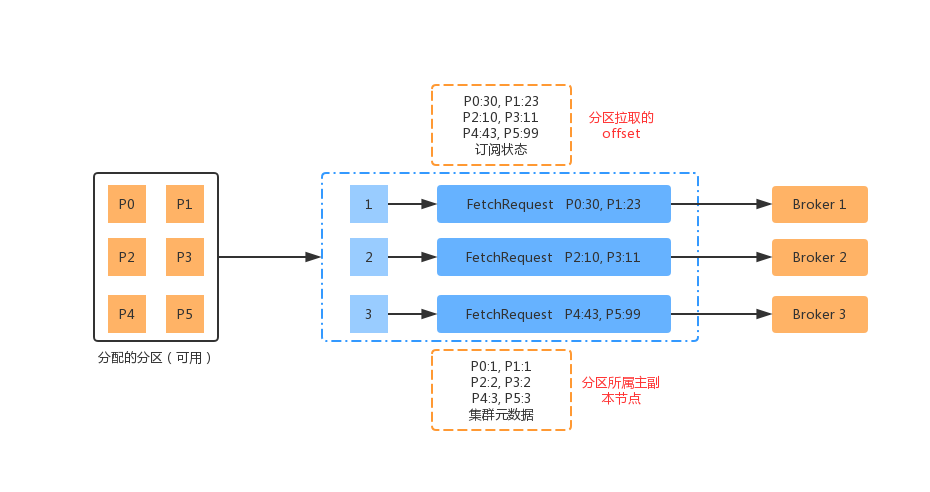
简单的描述一下上面的流程图:
(1)消费者向协调者申请加入 group,并得到分配给它的分区信息。
(2)集群元数据记录了分区及所属主副本节点的信息。
(3)消费者订阅状态记录了分区最近的拉取偏移量 offset 信息。
(4)Fetcher 发送请求时,会将所有分区按照Broker(主副本)的维度进行整理组装 FetchRequest。
(5)每个主副本对应一个FetchRequest,然后Fetcher 向Broker 发送请求。
下面我们看下具体的代码实现:
获取结果 Fetcher.fetchedRecords()
Fetcher 组件获取结果可能会直接利用上一次 KafkaConsumer.poll() 的 FetchRequest发送。此时如果我们假设 KafkaConsumer 订阅了 P0、P1、P2 三个分区,每次client.poll() 轮询会拿到4条消息,而一次fetch() 操作最多只可以获取2条消息(max.poll.records 设置的阀值)。此时可能会有如下流程:
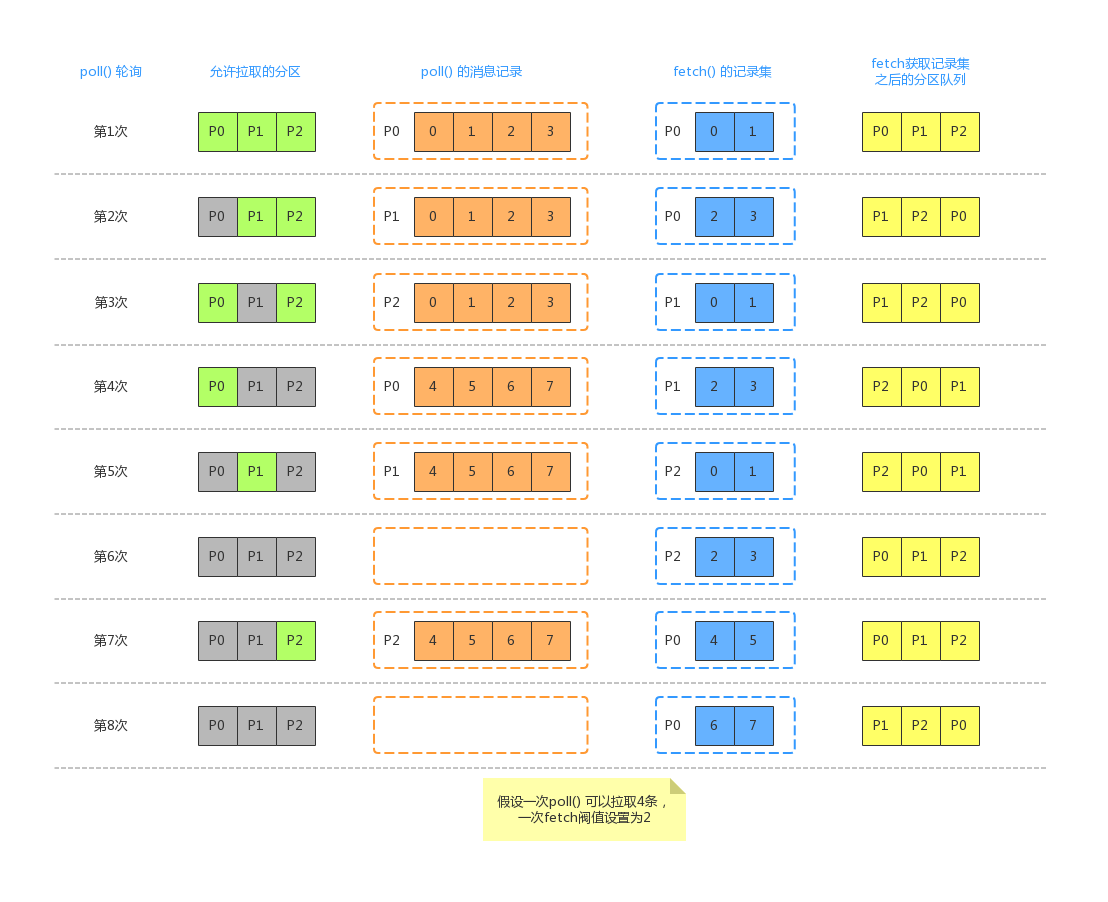
1、第一次调用 KafkaConsumer.poll() 获取消息时,允许拉取的分区是 P0、P1、P2(因为如果分区有未处理完成的记录,则不允许从服务端拉取,此时3个分区都没有未处理的消息在缓存中)。此时假设 Broker 端返回了 P0 的 0、1、2、3 四条消息,并存放在 P0 对应的缓存当中,同时返回的结果集只能给出 2 条,也就是 P0 的 0、1 。此时分区队列中的顺序还是 P0->P1->P2,因为P0 中的消息尚未处理完成,下一次 KafkaConsumer.poll() 还会继续从 P0 分区缓存中获取消息。
2、第二次调用 KafkaConsumer.poll() 获取消息时,允许拉取的分区是 P1、P2(此时P0尚有未处理完成的消息)。此时假设 Broker 返回了 P1 的 0、1、2、3 四条消息,并存放在 P1 对应的缓存中,但是此时给出的确是上面 P0 缓存中剩下的 2、3 两条消息。之后分区队列中的顺序变为 P1->P2->P0,下一次调用 KafkaConsumer.poll() 获取消息时,会首先从 P1 对应的缓存中获取数据。
3、第三次调用 KafkaConsumer.poll() 获取消息时,允许拉取的分区是 P0、P2(此时P0在缓存中的消息已经拉取完毕)。此时假设 Broker 返回了 P2的 0、1、2、3 四条消息,并存放在P2对应的缓存中,此时返回的是上一次结束分区队列头部的分区缓存中的数据,此时返回了 P1的0、1 两条消息。之后分区队列中的顺序不变,还是 P1->P2->P0,因为此时P1 缓存尚有数据。
4、第四次调用KafkaConsumer.poll() 获取消息时,只有P0 分区可以被拉取。此时假设 Broker 返回了 P0 的4、5、6、7 四条消息,并存放在P0对应的缓存中,此时返回了P1 的 2、3 两条消息,分区队列变为P2->P0->P1。
5、第五次调用KafkaConsumer.poll() 获取消息时,因为P1 缓存中的数据处理完了,此时只有P1 可被拉取。此时假设 Broker 返回了 P1 的 4、5、6、7 四条消息,并存放到P1对应的缓存中,此时返回了P2 的0、1 两条消息,分区队列依然为P2->P0->P1。
6、第六次调用KafkaConsumer.poll() 获取消息时,此时P0、P1、P2 分区对应的缓存中都有数据,此时没有分区可被拉取。此时直接返回P2 的2、3 两条消息。分区队列变为 P0->P1->P2。
7、第七次调用KafkaConsumer.poll() 获取消息时,此时只有P2 可以被拉取。此时假设 Broker 返回了 P2的 4、5、6、7 四条消息,并存放到 P2 对应的缓存中。此时返回了P0 的4、5 两条消息,分区队列依然为 P0->P1->P2。
8、第八次调用KafkaConsumer.poll() 获取消息时,此时无分区可被拉取。此时返回P0 的6、7 两条消息。分区队列变为P1->P2->P0。
下面我们看一下详细的代码实现:
参考:《Apache Kafka 源码剖析》、《Kafka技术内幕》、http://matt33.com/2017/11/11/consumer-pollonce/



